The history of aviation is filled with innovative designs, dreams, and ambitions, many of which never saw the light of day, despite their promises. Among these fascinating concepts, that were designed but never built, some stand out for their innovative designs, popularity, and potential to revolutionize air travel.
One such intriguing concept was the Tupolev Tu-404, a behemoth of a commercial aircraft proposed by the Russian aerospace company Tupolev in the early 1990s. It is the largest aircraft ever designed in the history of aviation, with the potential to carry a whopping 1,214 passengers in a single-class configuration across vast distances of up to 13,500 Km.
Besides Tu-404, which we have covered recently, this article explores some of the fascinating aircraft models, exploring their history, key specifications, and the reasons they never took flight.
1. Boeing 2707: America’s Supersonic Dream
In the 1960s, the United States entered the race to develop a supersonic passenger airliner to compete with the Anglo-French Concorde. Boeing was awarded the contract to create the American supersonic transport (SST), which resulted in the Boeing 2707. This aircraft was designed to carry passengers at speeds of up to Mach 2.7, promising to dramatically reduce transatlantic flight times.
The Boeing 2707 featured a swing-wing design, allowing the wings to pivot for optimal aerodynamics at both subsonic and supersonic speeds. Moreover, the swing-wing design was a variable-sweep wing design, which means the sweep angle could be adjusted during flight. However, during development, the required weight and size of this mechanism continued to grow, forcing the team to switch to a conventional delta wing.
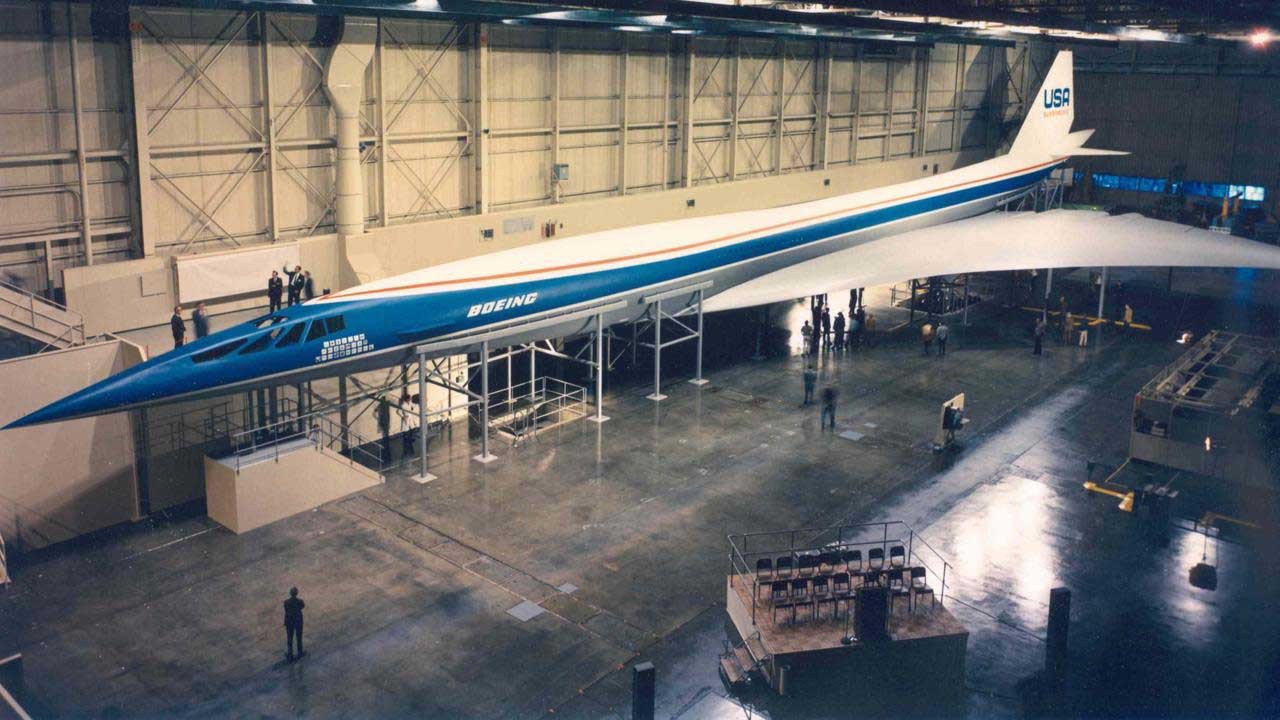
This ambitious design required advanced materials and engineering techniques. The aircraft was planned to be 93 meters long with a wingspan of 39 meters. It would carry between 250 and 300 passengers at a cruising speed of Mach 2.7, covering distances up to 6,850 kilometers.
However, the project faced numerous challenges. The complex swing-wing mechanism proved difficult to perfect, and environmental concerns about sonic booms and high fuel consumption further complicated matters. By 1971, escalating costs and changing political priorities led to the cancellation of the Boeing 2707 program, ending the United States’ venture into commercial supersonic flight before it took off.
At that time, there were 115 unfilled orders from 25 airlines, while Concorde had 74 orders from 16 customers. The two Boeing 2707 prototypes were never completed.
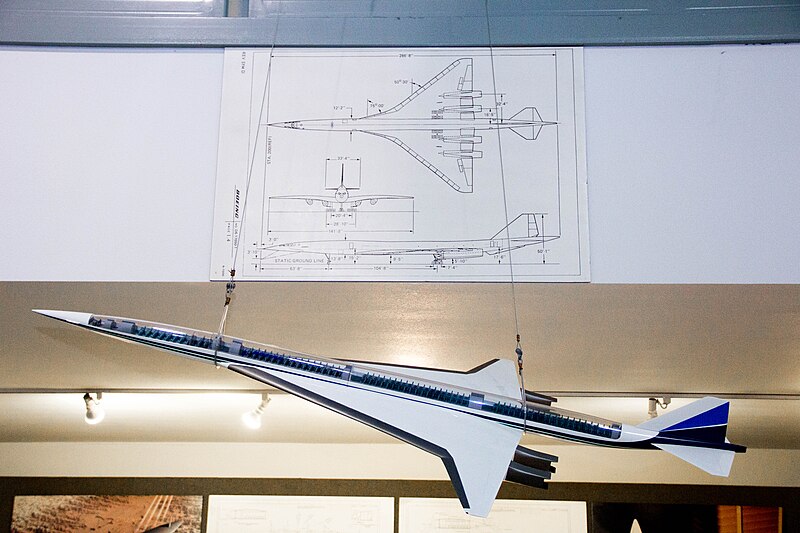
2. Boeing 747 Trijet: A Jumbo Jet Variant
During the late 1960s and early 70s, the aviation industry saw a trend towards trijet designs, with aircraft like the McDonnell Douglas DC-10 and Lockheed L-1011 TriStar gaining popularity. Boeing explored the idea of a trijet variant of its successful 747 jumbo jet to offer a more fuel-efficient alternative.
The center engine was designed to be fitted in the tail with an S-duct intake, similar to that of the L-1011. However, engineering studies revealed that a complete redesign of the 747 wing would be necessary. Maintaining the same handling characteristics as the original 747 was crucial to minimize pilot retraining.
Therefore, the Boeing 747 Trijet concept maintained the familiar dimensions of the 747, with a length of about 70.6 meters and a wingspan of 59.6 meters. The design included three high-bypass turbofan engines, which would potentially offer better fuel efficiency and flexibility in operations. This variant was aimed to carry between 350 and 400 passengers at a cruising speed of Mach 0.85, with a range of 9,800 kilometers.

Despite its potential, the 747 Trijet never moved beyond the conceptual stage. Boeing ultimately decided to focus on refining the four-engine 747 design, which had already proven to be reliable and popular among airlines. The resources were instead allocated to further developments of the existing 747 models, ensuring their continued success in the market.
Consequently, Boeing decided to develop a shortened four-engine version of the 747, which became the 747SP. In the 1990s, Boeing introduced the 777, a smaller long-range twinjet airliner that entered service in the market originally targeted by the 747-300.
3. Sukhoi KR-860: The Russian Superjumbo
In the 1990s, the Russian aerospace company Sukhoi introduced the KR-860, also known as the “Kryl’ia Rossii” (Wings of Russia). This double-decker aircraft was envisioned as a competitor to the Airbus A380, aiming to transport up to 1,000 passengers across long distances. A 1/24th scale model of KR-860 was displayed at the 1999 Paris Air Show.
The KR-860 boasted an impressive design, with a length of 80 meters and a wingspan of 88 meters. The aircraft featured two full passenger decks, offering unprecedented capacity and comfort. Powered by four turbofan engines, it was designed to cruise at Mach 0.86 and had an intended range of 15,000 kilometers. The KR-860 was marketed as an aircraft to revolutionize long-haul travel by accommodating a large number of passengers, with a capacity of 860–1,000 passengers.
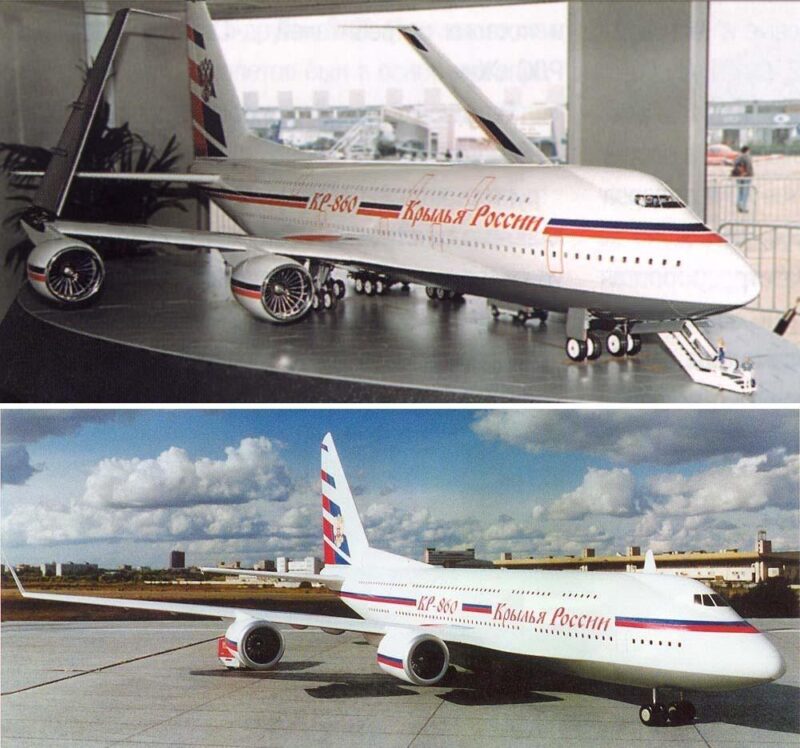
Moreover, the design had a maximum weight of about 650 tonnes and a payload capacity of approximately 300 tonnes. The main deck was configured with 12 abreast seating and three aisles, while the upper deck offered 9 abreast seating with two aisles. Passengers would enter through conventional fuselage doors or via forward and aft ventral escalators.
The wing design included winglets and a folding mechanism outboard of the outer engine. For comparison, the Antonov An-225 had a maximum weight of 640 tonnes and a payload capacity of 250 tonnes. If this aircraft had ever graced the skies, this aircraft would have been the world’s largest, widest, and heaviest airliner.
However, the collapse of the Soviet Union and the ensuing economic turmoil in Russia hindered the project’s progress. The financial instability, coupled with the uncertain demand for such a large aircraft, led to the abandonment of the KR-860. Despite its promising design, the aircraft remained a concept, symbolizing a bold yet unrealized vision for commercial aviation.
4. Lockheed A380
Before Airbus introduced its A380, Lockheed had envisioned a similar aircraft in the 1990s. The Lockheed A380 concept was aimed at the high-capacity, long-haul market, seeking to offer airlines a large, double-decker aircraft that could accommodate significant passenger numbers.
In the early 1990s, the aviation industry faced a significant problem: airports were becoming increasingly congested as air travel gained popularity. Airlines struggled to secure enough landing slots to meet the growing demand, with some airports like Heathrow being completely saturated and selling landing slot pairs for millions of pounds.
To address this issue, the solution was to increase the size of aircraft rather than the number of flights. Boeing had already started this trend with the 747, and Airbus was following suit with the A340 series. Lockheed Martin, having exited the commercial aviation market after the L-1011 trijet, saw an opportunity to develop the next logical step in commercial aircraft evolution. This has rise to the Lockheed A380 concept.

Lockheed Martin’s proposed design boasted a takeoff weight of 1.4 million pounds (635 metric tonnes) and was powered by four powerful engines. The aircraft featured an impressive wingspan of 282 feet (85 meters), with folding wingtips that reduced the span to 211 feet (64 meters), matching that of a Boeing 747.
At 262 feet long (79 meters), this aircraft was among the longest in the world. Its immense size would have required modifications to airport runways and gates, similar to those later necessitated by the Airbus A380. The aircraft would be powered by four high-bypass turbofan engines, ensuring the necessary thrust for such a large aircraft. However, in stark contrast, it only had a range of 3,200 nautical miles (5,900 km) in the design document.
The aircraft was designed to carry approximately 900 passengers, with 450 on each deck in a three-class cabin configuration. Its wide fuselage would have accommodated a 17-seat across arrangement, likely in a 3-4-3-4-3 configuration with four aisles. This is a stark contrast to the maximum of 10 seats across found in today’s largest aircraft.
In addition to its passenger version, Lockheed Martin also planned a cargo variant capable of transporting intermodal containers – the same containers used on trains, ships, and trucks. This subsonic aircraft could have held 16 containers on the lower deck while still carrying 450 passengers on the upper deck.
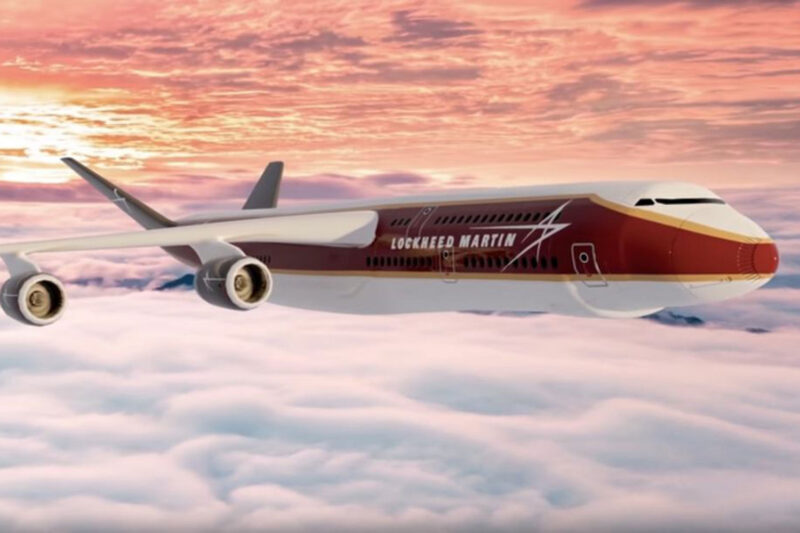
Despite its advanced design, Lockheed ultimately decided not to pursue the project. The high development costs and the significant risks associated with bringing such a large aircraft to market were major deterrents. Additionally, the unconventional design raised uncertainties about how the aircraft would perform in day-to-day flight operations and how it would handle the sky.
Lockheed Martin, having recently exited the commercial aviation market, found these challenges overwhelming. Consequently, the project was shelved. Nevertheless, Lockheed’s A380 concept remains a testament to the company’s forward-thinking approach, even though it never materialized.
5. McDonnell Douglas MD-12
In the early 1990s, McDonnell Douglas set out to revolutionize air travel with the introduction of the MD-12, a design intended to surpass the capacity of existing jumbo jets and offer unparalleled passenger comfort. Initially envisioned as a trijet larger than the MD-11, the MD-12 evolved into a quadjet airliner featuring two full-length passenger decks, designed to compete with the Boeing 747.
The journey of the MD-12 began with the MD-12X, an improved, stretched version of the MD-11. This initial concept included a possible lower-front passenger deck with panoramic windows and had impressive dimensions: a length of 72.5 meters (237 feet 11 inches) and a wingspan of 64.8 meters (212 feet 6 inches). In November 1991, McDonnell Douglas partnered with Taiwan Aerospace Corporation to form a new company to bring this design to life, with McDonnell Douglas holding 51% of the shares.

Later that year, McDonnell Douglas decided to separate its civil and military divisions to secure the estimated $4 billion needed for the MD-12X development. This move aimed to make civilian aircraft projects more attractive to investors by isolating them from the financial burdens of military projects like the C-17 airlifter.
The MD-12 eventually grew into a more substantial quadjet with two full-length passenger decks, capable of carrying between 430 and 511 passengers. The final design had a length of 63.4 meters (208 feet), a wingspan of 64.9 meters (213 feet), and a fuselage that was 7.39 meters (24 feet 3 inches) wide and 8.51 meters (27 feet 11 inches) high.
McDonnell Douglas officially unveiled the MD-12 in April 1992, positioning it as a direct competitor to future large aircraft like the Airbus A3XX and Boeing’s New Large Airplane. However, despite the initial excitement and aggressive marketing efforts, the MD-12 failed to secure any orders. The project’s downfall was accelerated when Taiwan Aerospace withdrew, leaving McDonnell Douglas without the necessary resources. Additionally, some speculated that the project was more of a strategic move to inflate McDonnell Douglas’s value in a potential sale to Boeing.
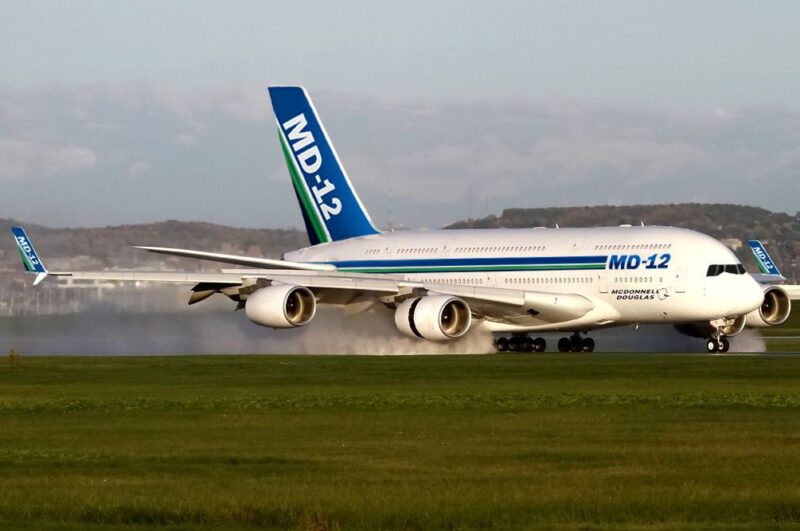
Ultimately, the MD-12 was abandoned due to its high development costs and the technical challenges of building such a large aircraft. The subsequent merger of McDonnell Douglas with Boeing in 1997 further diminished the likelihood of the MD-12’s revival, as Boeing focused on its own products. The development of a new double-deck widebody aircraft proved to be a complex and expensive endeavor, even for major aerospace companies. While Airbus eventually developed the A380, a similar concept to the MD-12, it did not achieve significant commercial success.
6. McDonnell Douglas MD-XX: The Ultra-Long-Range Jet
After shelving the MD-12 project, McDonnell Douglas turned its attention to derivatives of the MD-11, aiming to capture the market for 300 to 400-seat aircraft. At the 1996 Farnborough International Air Show, they introduced plans for the MD-XX, a new trijet designed for long-range travel and high seating capacity. The MD-XX was proposed in two variants: the MD-XX Stretch, with an extended fuselage, and the MD-XX LR, optimized for longer range.
Both variants of the MD-XX featured the same wingspan as the MD-12 at 64.9 meters (213 feet). The MD-XX Stretch was 32 feet (9.8 meters) longer than the MD-11, offering seating for 375 passengers in a three-class configuration or 515 in an all-economy layout, with a range of 13,000 kilometers (7,020 nautical miles). The MD-XX LR maintained the same length as the MD-11 but offered a longer range of 15,400 kilometers (8,320 nautical miles) and could accommodate 309 passengers in a three-class configuration. The MD-XX was designed to cruise at Mach 0.85.
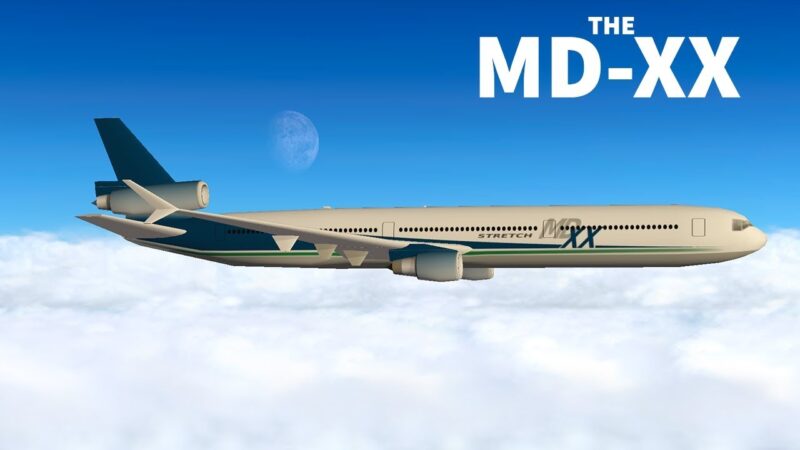
Despite its immense potential and promises, the MD-XX project was shelved following the merger of McDonnell Douglas with Boeing. Boeing’s existing models, such as the B777 and the forthcoming B787, rendered the MD-XX redundant. The ultra-long-range jet concept never progressed beyond the initial design phase, marking the end of McDonnell Douglas’s ambitious plans for long-haul aviation dominance.
Conclusion
These conceptual aircraft designs highlight some of the most ambitious and innovative designs in aviation history. While none of them ever took to the skies, their stories highlight the creativity and vision of aerospace engineers. Each of these aircraft types, whether hindered by technical challenges, economic constraints, or market conditions, contributes to the rich tapestry of aviation history. The legacies of these ambitious designs continue to inspire and remind us of the boundless possibilities in the field of aviation.




